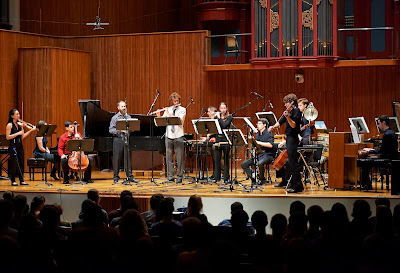Oberlin
Conservatory
October
5
 |
| Overflow crowds both onstage and in the audience. |
Modern
music is alive and well in Oberlin, where a packed Warner Hall
audience heard some impressive performances on Friday night from the
college’s Contemporary Music Ensemble and eighth blackbird, the
Chicago-based sextet that includes five Oberlin alumni. With CME
Director Timothy Weiss handling the conducting chores, the caliber of
playing was strikingly good, far out of proportion to the young
ages of the musicians.
Eighth
blackbird is in a category of its own, combining the expertise of a
dedicated contemporary music ensemble with the energy of a rock band
and a flair for theatrics. The group formed the backbone of a
12-piece ensemble that played the opening work, Skipping Stones
by Tom Lopez. Using the splashing sounds that a flat stone makes as
it skips across the water as a departure point, the piece offers a
series of delicate surface movements, then dives into deeper sounds
that eventually include rattling and knocking. With Lopez adding
electronics from the sound board, the group played the piece with
surgical precision, sans conductor. It ran out of gas at the end, but
otherwise made a light, witty opener.
Kaija
Saariaho’s Amers was the only piece on the program from the
international repertoire, a 1992 French-inspired spectral work played
by a 14-piece ensemble fronted by ’96 grad Nicholas Photinos on
cello. Weiss created a backdrop of vibrant colors and sparkling
clarity for an energetic performance by Photinos, who took his
instrument from frantic grumbling to ultra-fine extended single notes
with finesse. Amers is interesting mostly as an example of its
genre, but Weiss made it rich and evocative – no small
accomplishment with a piece that is mostly floating textures – and
Photinos added a frothy gusto.
Whirligig
is a piano piece for four hands by eighth blackbird keyboard player
Lisa Kaplan, who had great fun bringing out three different
colleagues to join her in a round robin for the three movements. The
mechanics are absurd, and deliberately so. Kaplan described the work
in the program notes as “getting in each other’s business and
relishing it,” with crossing hands the least complicated thing the
players are required to do. The first movement ends with one player
literally pushing the other off the piano bench. Whirligig got
some laughs during the performance and a big hand afterward, offering
an entertaining reminder that contemporary music need not all be
serious and cerebral.
Derek
Bermel’s fast-paced Tied Shifts gave eighth blackbird the
stage to themselves and a chance to indulge in a bit of choreography,
with the musicians moving around to play in different combinations.
Stockhausen notwithstanding, such movements are typically more about
style than substance. But eighth blackbird’s are done in service to
the music, adding another dimension to the sound. With Bermel’s
lightning rhythms driving both the music and the movement, it was a
smart, spirited excursion.
One
had to wonder if any of the 17 players onstage for Benjamin
Broening’s What the Light Was Like were old enough to vote,
much less play complicated contemporary music. Credit Weiss with a
light touch and particularly fine hand with sonic effects, creating a
carefully layered, often dramatic sound. The music was highly
descriptive and if not one of Broening’s more memorable works,
still a broad, richly colored canvas on which individual players were
able to leave their marks.
The
evening closed with Peter Swendsen’s Six Ways Through a Glass of
Absinthe, which mixes a grab bag of influences (Picasso,
Stravinsky, French pop) with recorded sounds (a café,
a carousel) to create a mosaic that ranges from minimalism to street
music. It never quite jelled, with the number of players onstage (12)
finally seeming cumbersome. The piece calls for some sharp changes of
timing and atmosphere, which a smaller group might have handled more
nimbly. Or maybe it’s just impossible to maintain such a high
caliber of playing with so many musicians across so many different
styles.
Either
way, there is no failing in being overly ambitious. And for the most
part, this was not only a good concert but a reminder of the talent
that Oberlin attracts and produces, with two of the composers and
almost all of the players Oberlin students or graduates. And that
enthusiastic fan base! Stockhausen should be so lucky.
For
more on eighth blackbird: http://www.eighthblackbird.org/
For
more on the Oberlin Contemporary Music Ensemble:
http://www.oberlin.edu/nyc2013tour/artists/cme.html
Photo by Roger Mastroianni
No comments:
Post a Comment